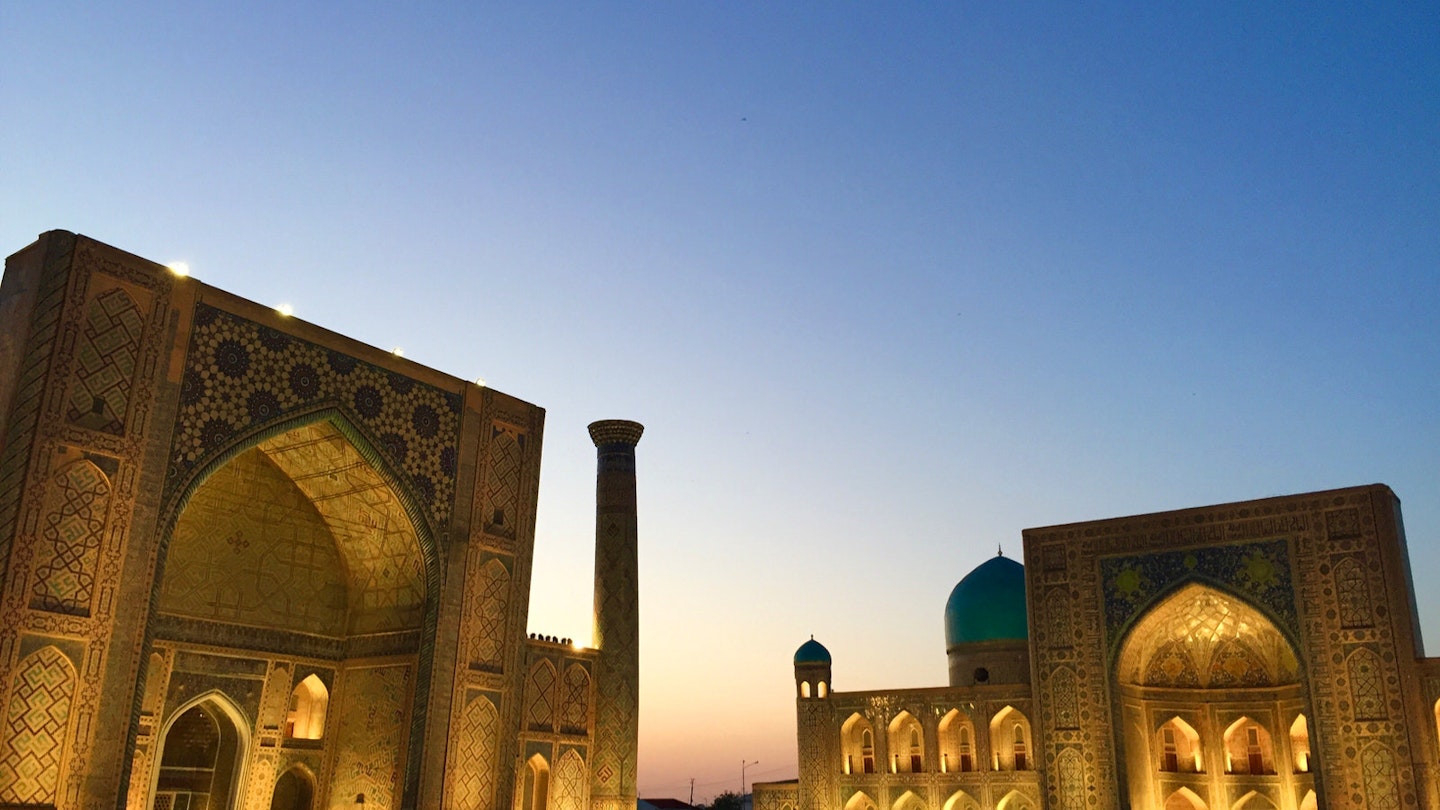Uzbekistan: the name conjures images of far-away mosques and blue-tiled domes, camels and caravanserai, mosaics and medressas. It’s true that Uzbekistan is the kind of destination that many people don’t reach, but the country has chugged into the new millennium with an excellent high-speed train network that makes traveling here much easier than many travelers might think.
The country’s three major cities, along with its most famous monuments, are all connected by bullet trains that make getting around fast and comfortable. History buffs, desert lovers, post-Soviet architecture seekers, and anyone drawn by the mystique of the Silk Road will find Uzbekistan a welcoming and surprisingly easy place to travel.
Uzbekistan’s Railway Network: What to Know
Uzbekistan’s high-speed train network – the Afrosiyob – connects its capital, Tashkent, with the major cities of Bukhara and Samarkand. Uzbekistan Railways utilizes Talgo-brand trains – the same roomy carriages found in Spain. There are three classes of travel: economy, business, and VIP, but even in economy, the double-seater, air-conditioned carriages are extremely comfortable, offering complimentary snacks of tea and biscuits, along with wide windows to watch the dusty Uzbek landscape zip by.
Tashkent
Uzbekistan’s tidy, gleaming capital city, Tashkent, nods to its Soviet past in monumental brutalist buildings, such as the stoic Hotel Uzbekistan, yet it manages to be far less austere than one might imagine. The desert climate here ensures blue skies most days, and the city employs a dedicated team of cleaners to maintain the cleanliness of the streets, gardens, and parks.
Don’t miss the Barak Khan Medressa and other treasures at Khast Imom Square. Additionally, stroll through the city’s main shopping hub, Chorsu Bazaar, where you can pick up fresh fruits, local pickles, knickknacks, and see an astonishing variety of meats from local butchers.
Train Tips
Tashkent’s railway station is a grand, blue-windowed structure dating back to the early 1980s. You’ll need photo ID to pass through security checkpoints to access the station. A few snack bars are located inside. The station is also served by Tashkent metro station on the blue Uzbekistan Line.
Bukhara
Often referred to as Central Asia’s holiest city, Bukhara is a millennium-old destination that best showcases the remains of the ancient Silk Road in their unrestored glory. Bukhara is home to numerous monuments, including the Kalon Mosque, whose minaret (built in 1127) is famously the only structure spared by Chinggis Khan during his rampages across the steppe. However, the true joy of visiting Bukhara lies in wandering around the city’s labyrinthine old town – a maze of mud-walled, low-rise structures connected by winding dirt streets.
Train Tips
The high-speed line has dramatically reduced train travel time between Tashkent and Bukhara from seven hours to just under three. The city’s train station is 10km south of the center, where taxi touts often wait in the parking lot when trains arrive. Bargain hard for a fair fare (around 4000 som should get you to town) or take Minibus 68 to Lyabi-Hauz.
Samarkand
For many, the name Samarkand is synonymous with the Silk Road, and indeed this ancient city fulfills most visitors’ dreams with its gleaming blue-tiled domes and elegant Timurid facades adorned with geometric patterns.
Historically, Samarkand was the very center of the world: nomads, traders, soldiers, and scholars traversed this crossroads city en route along the Silk Road. Ideas and goods that significantly shaped the world as we know it – including spices, fabrics, architectural styles, religious texts, and fashion trends – passed through the stunning Registan. This main square, flanked by three magnificent medressas, has become the iconic symbol of Central Asia.
Numerous mosques, medressas, and mausoleums (including the tomb of Persian ruler Timur himself, the Gur-e-Amir Mausoleum) are scattered throughout Samarkand, while its vibrant streets and bustling bazaars provide a delightful environment for exploration. Be sure to admire the Registan at sundown, when the blue desert light casts beautiful glints across the medressas, and once the sun sets, glowing lights illuminate the entire square.
Train Tips
Samarkand has been a hub for train travel since the first locomotives arrived at the end of the 19th century, when the Russian empire made it a stop on the Trans-Caspian Railway. The trip from Bukhara to Samarkand, as well as from Samarkand back to Tashkent, takes around two hours. A new tram system opened in Samarkand in April 2017, which will eventually connect the railway station with the city’s tourist center.
Khiva
The ancient walled city of Khiva, located in the far west of Uzbekistan, is one of the country’s Silk Road highlights, but due to its remote location, it is less busy than other attractions. Although Khiva is not yet part of the high-speed rail network, plans for a line extension will connect it to other cities soon.
Make It Happen
Most nationalities require a visa to enter Uzbekistan, but obtaining one from an Uzbek consulate or embassy is a relatively easy process. Accommodations will register your passport with local authorities, so be sure to keep the registration slips, as you might need them at the airport before departure. The national carrier, Uzbekistan Airlines, operates flights to many major cities around the world, while other airlines connect to Tashkent through various hubs.





